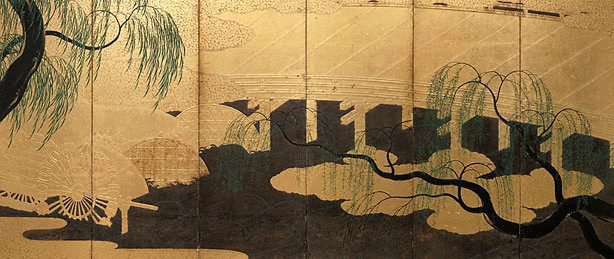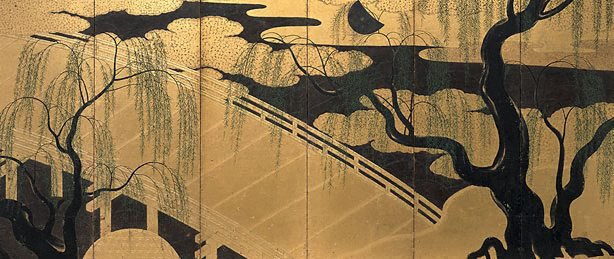

-
Details
- Place where the work was made
-
Japan
- Period
- Edo (Tokugawa) period 1615 - 1868 → Japan
- Date
- 17th century
- Media categories
- Screen , Painting
- Materials used
- pair of six-panel screens (byobu); ink, colour gold leaf on paper, lacquer frames with metal fittings
- Dimensions
-
a - right screen - large willow tree, 151.3 x 327 cm
b - left screen - water wheel, 151.3 x 327 cm
- Credit
- Purchased 2005
- Location
- Not on display
- Accession number
- 322.2005.a-b
- Copyright
- Share
-
-
About
These striking screens belong to a category of paintings in the native Japanese style known as 'meisho-e' (literally 'pictures of famous places'). The site depicted here is the Uji River Bridge, an important bridge linking the two historical cities of Kyoto and Nara. A beautiful scenic spot, Uji's features - willow trees, river mists, a waterwheel and stone-filled baskets to protect the river banks - have been celebrated in Japanese poetry since the eighth century, while it also provides the setting for the final scene in the Japanese classic 'The Tale of Genji'. Depictions of Uji are known to exist from the tenth century, and over the centuries the composition became bolder, shedding naturalism and adopting almost geometric stylisation. Sophisticated viewers could normally recognize the literary references from the few visual clues.
With their contrasts of large, dramatic forms and brilliant metallic shimmer, these spectacular screens represent the zenith of Japanese screen painting during the Momoyama (1568-1615) and early Edo periods (1614-1868), with lavish use of gold and dynamic asymmetrical composition. As a seasonal reference, the passage of time is implied by the changing size of the willow leaves as the viewer moves from right (spring) to left (summer) through the painting. Realism as well as decoration inspired the three-dimensional treatment of the silvered copper moon, now tarnished, and of the water wheels and baskets built up in gesso.
Stylised depictions of famous places were popular motifs during the early Edo period and there are a number of other Uji Bridge screens in Japan and America, all depicting the same scene with slight variations - without the moon, or incorporating different seasons, or including narrative details of rice paddies or river boats. However, there are no similar screens in European or Australian collections.
Asian Art Department, AGNSW, November 2005.
-
Places
Where the work was made
Japan
-
Exhibition history
Shown in 3 exhibitions
The art of Japanese screen painting, Art Gallery of New South Wales, Sydney, 06 Nov 2004–06 Feb 2005
Genji - the world of the Shining Prince, Art Gallery of New South Wales, Sydney, 12 Dec 2008–15 Feb 2009
In one drop of water, Art Gallery of New South Wales, Sydney, 15 Jun 2019–21 Feb 2021
-
Bibliography
Referenced in 1 publication
-
Art Gallery of New South Wales, Art Gallery of New South Wales annual report 2006, Sydney, 2006, 14 (colour illus.), 15 (colour illus.).
-
